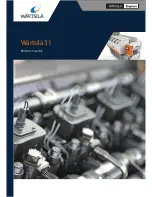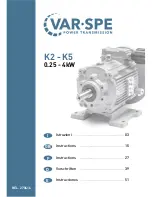
GEN III V8 ENGINE MANAGEMENT
Basic Knowledge and Tools Required
To use the VT Series Service Manual effectively, a general understanding of basic electrical circuits and circuit
testing tools is required You should be familiar with wiring diagrams, the meaning of voltage, ohms, amps, the
basic theories of electricity, and understand what happens in an open or shorted wire
To perform system diagnosis, the use of a Tech 2 is required A test light, digital volt-ohmmeter with 1 0
megohms impedance, vacuum gauge, and jumper wires are also required Please become acquainted with the
tools and their use before attempting to diagnose a vehicle
Electrostatic Discharge Damage
Electronic components used in control systems are often designed to carry very low voltage, and are very
susceptible to damage caused by electrostatic discharge It is possible for less than 100 volts of static electricity
to cause damage to some electronic components By comparison, it takes as much as 4,000 volts for a person
to even feel the zap of a static discharge
There are several ways for a person to become statically charged The most common methods of charging are
by friction and by induction An example of charging by friction is a person sliding across a car seat, in which a
charge of as much as 25,000 volts can build up
Charging by induction occurs when a person with well insulated shoes stands near a highly charged object and
momentarily touches earth Charges of the same polarity are drained off, leaving the person highly charged with
the opposite polarity Static charges of either type can cause damage, therefore, it is important to use care when
handling and testing electronic components
NOTE: To prevent possible Electrostatic Discharge damage
• Do Not touch the PCM connector pins
DIAGNOSTIC INFORMATION
The diagnostic charts and functional checks in the Service Manual are designed to locate a faulty circuit or
component through logic based on the process of elimination The charts are prepared with the requirement that
the vehicle
• Functioned correctly at the time of assembly
• There are no multiple faults
• The problem currently exists
The PCM performs a continual self-diagnosis on certain control functions This diagnostic capability is
complemented by the diagnostic procedures contained in the Service Manual The PCM's language for
communicating the source of a malfunction is a system of Diagnostic Trouble Codes (DTCs) The diagnostic
trouble codes are four digit (POXXX or P1XXX) When a fault is detected by the PCM, a diagnostic trouble code
is set and the Check Powertrain lamp may be illuminated
Self-Diagnostics
The PCM performs system self diagnostics, and can detect and often isolate system failures When a failure is
detected, the PCM sets a DTC that represents that failure and may or may not turn on the Check Powertrain
Lamp
Check Powertrain Lamp
The Check Powertrain Lamp is a Malfunction Indicator Lamp (MIL) and is located in the instrument panel and
has the following functions
• It is used as a bulb check, it will come on for two seconds when the ignition is turned on
• It informs the driver that a problem has occurred and that the vehicle should be taken for service as soon as
is reasonably possible
As a bulb and system check, the Check Powertrain lamp will come on for two seconds when the ignition is
turned on If the Check Powertrain lamp remains illuminated, the self-diagnostic system has detected a problem
If the problem goes away, the Check Powertrain lamp will go out in most cases after 1 0 seconds, but a
Diagnostic Trouble Code will be stored in the PCM
When the Check Powertrain lamp remains on while the engine is running, or when a malfunction is suspected
due to a dnveability or emissions problem, an On-Board Diagnostic System Check must be performed. The
procedure for this check is given in the Service Manual These checks will expose malfunctions which may not
be detected if other diagnostics are performed prematurely
GEN III V8 ENGINE MANAGEMENT Page - 7
Summary of Contents for GEN III V8
Page 1: ...HOLDEN GEN III V8 ENGINE MANAGEMENT...
Page 3: ......
Page 4: ...GEN III V8 ENGINE MANAGEMENT CONTENTS SUBJECT GEN III V8 ENGINE MANAGEMENT...
Page 5: ...GEN III V8 ENGINE MANAGEMENT NOTES GEN III V8 ENGINE MANAGEMENT...
Page 7: ...GEN III V8 ENGINE MANAGEMENT Page 2 GEN III V8 ENGINE MANAGEMENT...
Page 8: ...GEN III V8 ENGINE MANAGEMENT Page 3...
Page 14: ...GEN III V8 ENGINE MANAGEMENT GEN III V8 ENGINE MANAGEMENT Page 9...
Page 16: ...GEN III V8 ENGINE MANAGEMENT GEN III V8 ENGINE MANAGEMENT Page 1 1...
Page 20: ...GEN III V8 ENGINE MANAGEMENT GEN III V8 ENGINE MANAGEMENT Page 15...
Page 25: ...GEN III V8 ENGINE MANAGEMENT NOTES Page 20 GEN III V8 ENGINE MANAGEMENT...
Page 29: ...GEN III V8 ENGINE MANAGEMENT Paqe 24 GEN III V8 ENGINE MANAGEMENT...
Page 30: ...GEN III V8 ENGINE MANAGEMENT GEN III V8 ENGINE MANAGEMENT Page 25...
Page 31: ...GEN III V8 ENGINE MANAGEMENT Page 26 GEN III V8 ENGINE MANAGEMENT...
Page 72: ...GEN III V8 ENGINE MANAGEMENT GEN III V8 ENGINE MANAGEMENT Page 67...
Page 85: ...GEN III V8 ENGINE MANAGEMENT Page 80 GEN III V8 ENGINE MANAGEMENT...
Page 90: ...GEN III V8 ENGINE MANAGEMENT GEN III V8 ENGINE MANAGEMENT Page 85...
Page 94: ...GEN III V8 ENGINE MANAGEMENT GEN III V8 ENGINE MANAGEMENT Page 89...
Page 104: ...GEN III V8 ENGINE MANAGEMENT GEN III V8 ENGINE MANAGEMENT Page 99...
Page 113: ...GEN III V8 ENGINE MANAGEMENT NOTES Page 108 GEN III V8 ENGINE MANAGEMENT...













































